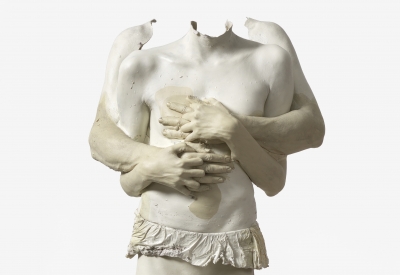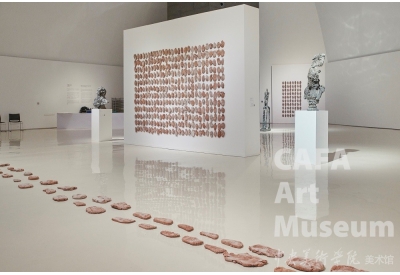Marc Quinn: A Metaphor for Being
Zhang Zikang
The Director of the Central Academy of Fine Arts Art Museum
British art has shaken up the art world since the 1990s withits pioneering, manifold, atypical and assertive styles; the influence has been long-lasting and extensive. CAFA Art Museum nowpresents one of the most iconic artists in this salient phase of British art history, Marc Quinn’s inaugural solo museum exhibition in China. Quinn came to prominence thirty years ago. He is known for his passion about materiality and his audacious use of materials: he made bread sculptures in his early days (he baked the breads in the shape of his own hands); he is no conservative when it comes to materials - ice blocks, glass, marbles, biological DNA, blood and other organic elements; the materiality underscores the fundamental subject of human existence, i.e. the perception of beauty and abnormality as well as its underlying cultural and social connotations. Through his use ofincomplete bodies, blossoming flowers, anamorphoseand flamboyant colouration, he explores themes such as identity, perception of beauty, human desire and how nature is mediated by such desire……the recurring juxtapositionsand contrasts in Quinn’s work are very interesting: traditional materials combined with state-of-the-art technology, abstract concepts projected by figurative forms and so on. In some of his works, the artist repeatedly investigates the forms of a medium inextreme physical conditions, which manifesting aconfluenceof contemporary art and science. With the prudentspirit ofa scientist and the incisive thinking of a philosopher, he redefines the language of art.
CAFA Art Museum has established multilateral relationships with many British artists, museum directors, curators and critics in the recent decade, and has created constant and systematic intercommunication with them. We collaborated with the Victoria and Albert Museum in 2010 to present an exhibition ‘Decode: Digital Design Sensation’; we have presented solo exhibitions of celebratedBritish artists and designers; we also hosted ‘The Sino-British Museum Forum’ in collaboration with TATEin 2016; in 2018, we continued to work with TATEto launch a series of exhibitions across England; and we have a number of exhibitions of acclaimed artists coming soon. The Central Academy of Fine Arts and CAFA Art Museumhave become a role model of cross-border cultural exchange through its multi-faceted, multi-dimensional and multi-layeredcooperation with British art experts and professionals. We anticipate working further with the global art community, enhancing mutual understanding and bringing great diversity into our museum.
Marc Quinn: A Metaphor for Being
Zhang Zikang
The Director of the Central Academy of Fine Arts Art Museum
British art has shaken up the art world since the 1990s withits pioneering, manifold, atypical and assertive styles; the influence has been long-lasting and extensive. CAFA Art Museum nowpresents one of the most iconic artists in this salient phase of British art history, Marc Quinn’s inaugural solo museum exhibition in China. Quinn came to prominence thirty years ago. He is known for his passion about materiality and his audacious use of materials: he made bread sculptures in his early days (he baked the breads in the shape of his own hands); he is no conservative when it comes to materials - ice blocks, glass, marbles, biological DNA, blood and other organic elements; the materiality underscores the fundamental subject of human existence, i.e. the perception of beauty and abnormality as well as its underlying cultural and social connotations. Through his use ofincomplete bodies, blossoming flowers, anamorphoseand flamboyant colouration, he explores themes such as identity, perception of beauty, human desire and how nature is mediated by such desire……the recurring juxtapositionsand contrasts in Quinn’s work are very interesting: traditional materials combined with state-of-the-art technology, abstract concepts projected by figurative forms and so on. In some of his works, the artist repeatedly investigates the forms of a medium inextreme physical conditions, which manifesting aconfluenceof contemporary art and science. With the prudentspirit ofa scientist and the incisive thinking of a philosopher, he redefines the language of art.
CAFA Art Museum has established multilateral relationships with many British artists, museum directors, curators and critics in the recent decade, and has created constant and systematic intercommunication with them. We collaborated with the Victoria and Albert Museum in 2010 to present an exhibition ‘Decode: Digital Design Sensation’; we have presented solo exhibitions of celebratedBritish artists and designers; we also hosted ‘The Sino-British Museum Forum’ in collaboration with TATEin 2016; in 2018, we continued to work with TATEto launch a series of exhibitions across England; and we have a number of exhibitions of acclaimed artists coming soon. The Central Academy of Fine Arts and CAFA Art Museumhave become a role model of cross-border cultural exchange through its multi-faceted, multi-dimensional and multi-layeredcooperation with British art experts and professionals. We anticipate working further with the global art community, enhancing mutual understanding and bringing great diversity into our museum.

2 pieces

2019-02-25

2019-04-23


